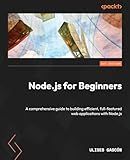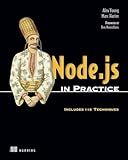Best Tools to Get Post Request Data in Node.js to Buy in December 2025

Node.js for Beginners: A comprehensive guide to building efficient, full-featured web applications with Node.js



Efficient Node.js: A Beyond-the-Basics Guide



NPM Node Package Manager: The Complete Tutorial



Node.js in Practice



Express in Action: Writing, building, and testing Node.js applications



Automating with Node.js



Building Scalable Web Apps with Node.js and Express: Design and Develop a Robust, Scalable, High-Performance Web Application Using Node.js, ... (Full Stack Web Developer — MEVN Path)


In Node.js, you can get the post request data by using the body-parser middleware. This middleware allows you to parse the incoming request body in a format that can be easily accessed in your code.
To use body-parser, first install it using npm:
npm install body-parser
Next, require and use it in your Node.js application:
const express = require('express'); const bodyParser = require('body-parser');
const app = express();
// Parse incoming request bodies app.use(bodyParser.urlencoded({ extended: false })); app.use(bodyParser.json());
// Handle post request app.post('/data', (req, res) => { const postData = req.body; // Request data is stored in req.body res.send('Data received: ' + JSON.stringify(postData)); });
app.listen(3000, () => { console.log('Server is running on port 3000'); });
In this example, the post request data received in the /data route is accessed using req.body. This data can then be processed or used in your application as needed.
How do I access post request data in node.js using Express?
In Express, you can access POST request data through the req.body object. To do this, you first need to install the body-parser middleware by running npm install body-parser in your project directory.
After installing body-parser, you need to import it in your Express application and use it as middleware to parse incoming request bodies. Here's an example of how you can use body-parser to access POST request data:
const express = require('express'); const bodyParser = require('body-parser');
const app = express();
// parse application/x-www-form-urlencoded app.use(bodyParser.urlencoded({ extended: false }));
// parse application/json app.use(bodyParser.json());
app.post('/example', (req, res) => { console.log(req.body); res.send('POST request received'); });
app.listen(3000, () => { console.log('Server is running on port 3000'); });
In this example, the req.body object will contain the parsed JSON or URL-encoded data from the POST request. You can access the data by accessing the properties of the req.body object.
What is the common practice to process post request data in node.js?
In Node.js, the common practice to process POST request data is to use the built-in body-parser middleware. This middleware is used to parse the incoming request body and make it more readable for the server to process.
Here is an example of how to use body-parser to process POST request data in Node.js:
- Install body-parser package using npm:
npm install body-parser
- Require body-parser in your Node.js application:
const bodyParser = require('body-parser');
- Use body-parser middleware in your application:
// parse application/x-www-form-urlencoded app.use(bodyParser.urlencoded({ extended: false }));
// parse application/json app.use(bodyParser.json());
- In your route handler, you can access the POST request data using req.body:
app.post('/endpoint', (req, res) => { const postData = req.body; // Process the postData here });
By following these steps, you can easily process POST request data in Node.js using the body-parser middleware.
How do I retrieve and process post request data in node.js?
In Node.js, you can retrieve and process POST request data using the body-parser middleware. Here's an example of how you can do this:
- Install body-parser module by running npm install body-parser in your project directory.
- Require the body-parser module in your Node.js application:
const bodyParser = require('body-parser');
- Use the body-parser middleware to parse incoming request bodies in your application:
app.use(bodyParser.urlencoded({ extended: true })); app.use(bodyParser.json());
- Handle the POST request in your Node.js application:
app.post('/your-endpoint', (req, res) => { const postData = req.body; // Process the POST data here res.send('Data received: ' + JSON.stringify(postData)); });
- Send a POST request to your endpoint with data in the body. You can use tools like Postman to test your POST request.
- The req.body object will contain the data sent in the POST request body. You can access and process this data as needed in your application.
That's it! You can now retrieve and process POST request data in your Node.js application using the body-parser middleware.
How to parse post request data in node.js?
To parse post request data in Node.js, you can use the body-parser middleware. Here's how you can do it:
- Install body-parser by running the following command:
npm install body-parser
- Require body-parser in your Node.js application:
const bodyParser = require('body-parser');
- Set up body-parser middleware in your Express application:
app.use(bodyParser.urlencoded({ extended: false })); app.use(bodyParser.json());
- Access the parsed data in your route handler:
app.post('/endpoint', (req, res) => { const postData = req.body; // Do something with postData });
Now, when a POST request is made to your endpoint, body-parser will parse the request body and make it available in the req.body object for you to use in your route handler.
